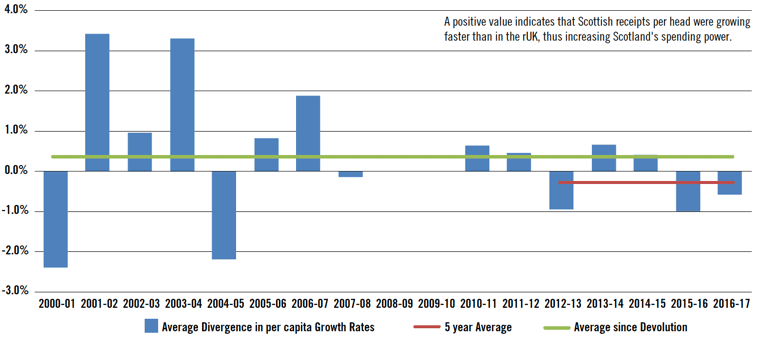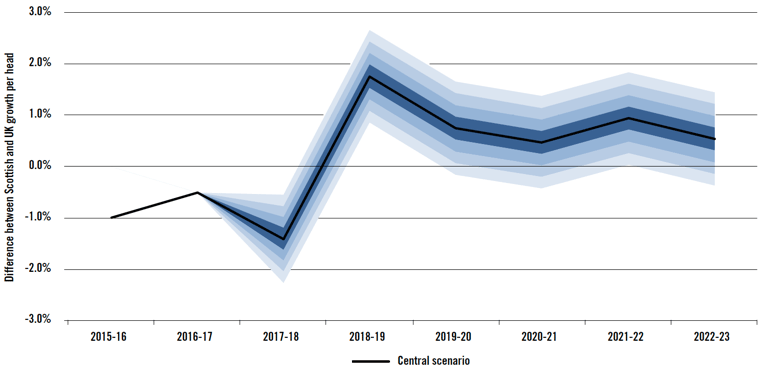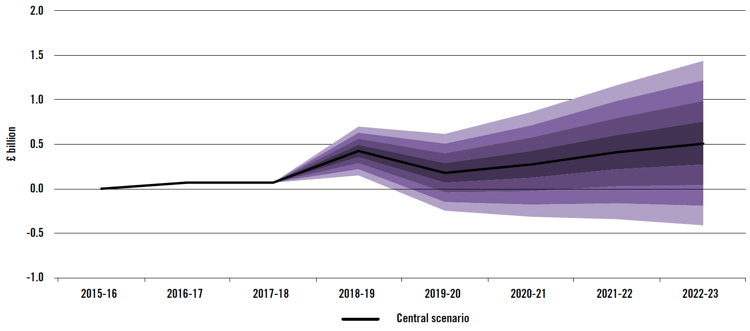Scotland's Fiscal Outlook: the Scottish Government's five-year financial strategy
The medium-term financial strategy is a key part of the revised Parliamentary budget process that has arisen out of the Budget Process Review Group.
Annex B: Further Detail on Economic Modelling
Constructing the central scenario
B.1. The central scenario of Scottish Government funding is built up by forecasting separate elements of funding and then aggregating these to produce a path for the total level of potential funding. The elements of income are:
- the resource budget limit (excluding new social security funding);
- new social security funding;
- the capital budget limit;
- Financial Transactions;
- net Block Grant Adjustment ( BGA) income;
- non-domestic rates income; and
- capital borrowing.
B.2. For the years up to and including 2019-20, the central forecast is taken from the Scottish Government Draft Budget 2018-19, adjusted for Scottish Rate Resolution tax changes. Beyond 2019-20, the approach to forecasting each component is set out below.
Fiscal resource budget limit excluding social security
B.3. In general, the fiscal resource budget limit is assumed to grow in line with overall UK Resource Departmental Expenditure Limit ( RDEL) from the UK Office for Budget Responsibility ( OBR) March 2018 Economic and Fiscal Outlook. [20] However, there are a small number of additional sources of income which are treated separately. These relate to: non-domestic rates; Scotland Act Implementation; the Migrant Surcharge; the Queen's and Lord Treasurer's Remembrancer ( QLTR); and the Rail Resource Grant. Separate forecasts of these sources are available out to 2022-23. Therefore, the fiscal resource budget limit is projected excluding these items, and then combined with the forecast of these individual elements to produce the overall projection.
New social security funding
B.4. The forecast for social security funding is based on projections produced by Scottish Government analysts.
Capital budget limit
B.5. UK spending plans for capital have been set out to 2020-21, one year further than for resource, so a figure is available for the capital budgets which is used as the baseline for future growth. The capital budget limit is then assumed to grow in line with the overall UK Capital Departmental Expenditure Limit ( CDEL) from the OBR March 2018 forecast.
Financial Transactions
B.6. Financial Transactions in 2020-21 are expected to fall in line with plans set out at the last UK Spending Review. Beyond 2020-21, there is no new lending and Financial Transactions are kept constant in cash terms. The risk around loss of Financial Transactions is reflected in the scenarios for the capital budget.
Net Block Grant Adjustment
B.7. Beyond 2019-20, the net Block Grant Adjustment for Scotland is forecast to grow in line with the SFC's forecast for devolved taxes, relative to the OBR's forecast for the rest of the UK.
Non-domestic rates income
B.8. Non-domestic rates income is forecast to grow in line with the SFC's forecast.
Capital borrowing
B.9. Capital borrowing powers are assumed to be fully utilised in 2019-20, but no capital borrowing is currently planned after this.
B.10. This approach is summarised below in Table B.1.
Table B.1 – Forecasts of individual income components (£ million)
| 2019-20 | 2020-21 | 2021-22 | 2022-23 | |
|---|---|---|---|---|
| Latest estimate | Forecast using: | Final estimate | ||
| Total budget excl non-cash | £33,024 | Sum of individual series | £37,555 | |
| Fiscal resource budget limit | £27,440 | UK departmental resource spend 1 | £28,709 | |
| New social security funding | £507 | Scottish Government projections | £3,602 | |
| Capital budget limit | £3,926 | UK departmental capital spend 1 | £4,226 | |
| Financial Transactions | £519 | 2020-21 budget figure then held flat | £505 | |
| Net Block Grant Adjustment | £182 | Relative devolved tax growth per head | £513 | |
| Capital borrowing | £450 | No decision on borrowing beyond 2019-20 | £0 | |
1 Source: OBR, series Public Sector Current Expenditure ( PSCE) in RDEL and Public Sector Gross Investment ( PSGI) in CDEL
Assumptions on historical performance and uncertainty
B.11. The impact of devolved taxes on the Scottish Budget is determined by changes to the accompanying Block Grant Adjustment ( BGA). As the BGA grows in line with tax receipts per head in the rest of the UK, the Scottish Budget will only be better off if Scotland can grow its tax revenues per head more quickly than the rest of the UK.
B.12. To understand the risks around this, we consider how tax receipts in Scotland have performed historically. The section below shows how this approach is implemented using income tax as an example.
B.13. As indicated in Chart B.1, non-savings and non-dividend ( NSND) income tax liabilities per head have grown faster in Scotland than the rest of the UK in nine out of the 15 years for which data is available. However, this is partly due to a relatively strong performance in the years immediately following the 1999 devolution settlement.
B.14. Two patterns can be observed from Chart B.1. Firstly, the divergence between tax per head growth appears to have decreased quite significantly and has not exceeded 1.0 percentage points since 2009-10. Secondly, looking at the performance over the past five years, the UK has grown more strongly in three out of the past five years, with the differential averaging -0.3 percentage points over this period.
Chart B.1 – Differential Growth in Income Tax Liabilities

Source: GERS 2016-17. Figures up to and including 2014-15 are provided by HMRC. Figures for 2015-16 and 2016-17 are OBR estimates.
Uncertainty analysis
B.15. The OBR and the Bank of England ( BOE) both use fan charts to present uncertainty around their central forecasts.
B.16. Chart B.2 illustrates Scottish Government estimated uncertainty about the SFC's central forecast for the difference in Scottish and UK growth in income tax liabilities. The SFC currently forecasts that per person NSND income tax receipts in Scotland will grow faster than in the rest of the UK from 2018-19. This is primarily due to different choices about the future path of income tax policy in Scotland. For example, in the chart below, Scottish receipts are forecast to grow faster than the rest of the UK by 1.8 percentage points in 2018-19 largely due to the Scottish Government's decision to introduce a new five band income tax regime in that year.
Chart B.2 – Uncertainty Around Differential Growth in NSND Income Tax Liabilities

B.17. A variety of ways exist to estimate this uncertainty. The approach used by the OBR is to draw lessons from the accuracy of previous forecasts as a guide to the accuracy of any current forecast. However, as forecast errors are not available for Scottish income tax, we currently take an alternative approach in estimating the level of uncertainty. This approach will be reviewed in future, and it is expected that further information will be built into the modelling in future years as information and understanding of the uncertainty in the Fiscal Framework increases.
B.18. The Scottish Government modelling approach is to base the future uncertainty on the historical variation in the data. Looking at the range of different values that have occurred in previous years allows us to construct a range of possible values that may occur in the future. This approach has a number of advantages. First, the process is relatively non-subjective, as the future values are drawn from available historical data. Second, we can adjust the model to capture the fact that uncertainty grows as the length of the forecast horizon expands. We base this adjustment on work undertaken by the OBR, who allow the variance of their distributions to expand year-on-year.
B.19. This is illustrated in Chart B.3 which shows the impact and level of uncertainty for Scotland's net spending power in relation to all the devolved taxes. Forecasts inevitably become more uncertain the further we look ahead. This means that by 2022‑23 Scotland's net spending power could be between -£414 million and +£1.4 billion, with the SFC's central estimate at £513 million (based on Scottish Government forecasts of the BGA and the SFC central tax forecasts).
Chart B.3 – Forecast of Scotland's Spending Power: Net Block Grant Adjustment

Contact
There is a problem
Thanks for your feedback